Common Indian Spices

Spice is the essence of Life
Spices add taste, flavour, aroma, colour and 'bite' - pungency to our food. Eastern civilization considers spices as indispensable ingredients. Spices or Masala are even used as preservatives and aphrodisiacs in traditional Asian medicine. Indian Cooks depend on these Spices (grown mostly in the Southern India), masalas to carefully control the taste in their kitchen. Many Indian grandmas prefer a strong decoction (called as 'Kashayam' in Tamil)made of some spices to drive away ailments. In fact Spices are extremely important in Indian recipes. They say in Tamil - Aru Suvai Unavu - literally meaning that the food has 6 unique tastes. In the Book - 'Doctor's Book of Natural Health Remedies' they say "Humans recognize six distinct tastes—sweet, sour, salty, bitter, savory and astringent—and each plays a role in feeding your body and mind."
Spices are like paint pallet. Just as a painter unleashes his creativity through the medium of different colors in the paint pallet, a Cook celebrates his/her creativity with a blend of spices. The Indian Curry may have infinite variety but it is made of spices - primarily black pepper,cardamom, Cinnamon, Coriander, Cumin, mustard seeds and turmeric. Every gravy made in South India - uses freshly ground spices in strategic proportions.
In this page, I list the most common 20 Indian Spices, their names in local languages, their Latin names and their health benefits. At the end of the page, I have added recipes to make Masala powders - Garam Masala and Madras Curry Powder from my personal notes.
Spices are derived from some part of a plant - flowers, fruits, leaves, seeds, rhizomes, roots, buds and even the bark of a tree. India produces almost all of the spices, largely owing to its varying climate and soil condition. According to the Indian Spice board, India produces 3.2 million tonnes of spices valued at approximately US$ 4000,000,000. India has about half the share of the world trade in Spices.
Essential Indian Spices
Pepper - This hot spice was probably one of the reasons why the medieval Europeans established a trade link to India. Even a simple dish like an omlette requires pepper. Rightly called as the King of Spices, pepper is available in different shades,depending upon the pungency. Black pepper (the strongest in flavor) is considered as a stimulant,carminative, aphrodisiac, diuretic and digestive in the traditional Indian medicine. Pepper, as 'Milagu tanner' - Pepper water (or 'Milagu rasam') is the final part of a South Indian meals, greatly assisting the digestion. They are also useful for asthma, fever, cough, dysentery, dyspepsia and flatulence. In powdered form (as a poultice) Pepper is useful for arthritis.
Essential oil of Pepper is useful to alleviate the symptoms of neuralgic and arthritic pain.
Latin - Piper nigrum
Family - Piperaceae
French - Poivre
German - Pfeffer
Tamil - Milagu
Hindi - Kali Mirch
Kannada - Kari menasu
Malayalam - Kuru milagu
|
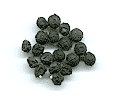 |
Ginger - Fresh Ginger is extremely important in oriental food. It is used to
flavour the cooking oil before you toss everything else for stir-frying. It is considered
as a restorative, stimulant and a strong flavouring agent. Ginger is reputed to cure
ulcers when chewed in small doses. It amply enhances your appetite when blended with other
spices. In villages, people make candies out of dried ginger for its various medicinal
properties. Most Asian recipes will be incomplete without Ginger.
There is another less pungent variety of ginger - known as Mango ginger - which is lighter in color and texture. This mango ginger is usually used raw in salad or added to yoghurt.
Health Benefits of Ginger : Ginger is a stimulant that can also lower Cholesterol and inflammation. Its anti-inflammatory properties help alleviate the pains of Arthritis. Ginger can control nausea, vomiting, motion sickness and morning sickness associated with pregnancy.
Ginger is useful in increasing blood circulation and also as blood thinning agent. Slivers of ginger steeped in hot water can be used to alleviate cold, ulcer and to improve digestion.
Latin - Zingiber officinale Roscoe
Family - Zingiberaceae
French - Gingembre
German - Ingwer
Tamil - Inji
Hindi - Adrak
Kannada - Shunti
Malayalam - Inji
|
 |
Garlic- This hardy bulbous annual has acclaimed medicinal value from the
ancient times. It lowers bad cholesterol and enhances blood circulation amongst
other things. In food, it adds its strong flavour. In combination with Onions, Garlic is
indispensable in soups, meat dishes,stews and marinade. Garlic also acts as a natural cure to control atherosclerosis. Unlike aspirin, Garlic doesn't cause stomach irritation - but has blood thinning properties.
Health Benefits of Garlic : Has powerful antibiotic and antifungal properties. Controls cough and respiratory problems. Lowers cholesterol, high blood pressure and acts as a strong blood thinner. Here is a simple but effective Home remedy for Cough and Cold:
- 1 Clove of Crushed Garlic - Garlic and Ginger work best as remedies when you crush them - with the back of your knife
- 1 one-inch sliver of Ginger - crushed
- Juice of 1 Lemon
- 1 teaspoon of Honey
- 1 Cup of Hot Water
Place all the above items in a vessel with a tight fitting lid. After 15 minutes, drain and drink the liquid in equal measures for about 5 times.
Latin - Allium sativum
Family - Liliaceae
French - Ail
German - Knoblanch
Tamil - Poondu
Hindi - Lehsan
Kannada - Bellulli
Malayalam - Vellulli
|
 |
Chilli - An indispensable culinary spice, it comes in various shapes and colours
and called variously as red chillies, Green chilies, capsicum, bell pepper, sweet pepper,
red pepper, cayenne pepper and paprika. It forms the major ingredient in Asian masala.
Consumption of chillies is high in India as it is used universally in Indian kitchens. Hot Chilies enhance sweat secretion to control body temperature. No wonder chilies are consumed in large quantities in hot Indian subcontinent. In fact, India produces 800,000 tonnes of dry chillies alone annually. Red chillies
derive their deep rich red colour from the pigment capsanthin. The 'hot'
pungency is associated with Capsaicin. The bell pepper or Capsicum is hardly pungent and
mainly adds texture and green colour to Uppumas and noodles. Eastern meat dishes will be
nothing without a dash of ground chillies. Discard the seeds and the membrane if you prefer it milder when
you add green chilies in some of the recipes listed.
Health Benefits of Chilies Chilies boost your metabolism and burn up fat. Regular intake of Chilies in food can improve blood circulation in extremities. Capsaicin in the chilies can stimulate digestion, reduce hunger and food cravings - thereby effectively controlling weight gain. Some studies claim that chilies have a positive effect on regulating blood sugar levels. A green chili is rich in Vitamin C and Capsaicin which works as an antioxidant and may ward off colon cancer. Chili seeds can ease constipation and the body of a green chili can be an effective remedy for diarrhea.
Latin - Capsicum annum
Family - Solanaceae
French - Puvre de Guinee
German - Paprika
Tamil - Milagai
Hindi - Mirch
Kannada - Menasinakayi
Malayalam - Mulaku
|
 |
 |
Cumin - Has a strong flavour akin to caraway. This spice is essential for
curries and curry powder. Roasted and ensconced in sugar syrup, can be ideal after a heavy
meal. Cumin improves digestion and reduces flatulence. This is probably the main reason why from the ancient Indians to the Moghul cooks preferred this spice and made use of this in all their recipes. For women - adequate intake of Cumin helps to reduce Uterine inflammation and painful periods.
Latin - Cuminum cyminum
Family - Apiaceae
French - Cumin
German - Romischer Kummel
Tamil - Jeerakam
Hindi - Jira
Kannada - Jeerage
Malayalam - Jeerakam
|
 |
 |
Coriander - This fragrant spice is used for sauces and as a condiment. The fresh
young leaves of this herb is used to flavour and garnish soups,salads and meat dishes. Coriander is another spice which promotes digestion and also acts as a carminative. Dry roasted Coriander enhances the flavor of this spice. ( dry roasting always helps to release the essential oils from the spices. This is the reason traditional Indian cooks roast the spices before grinding them. The strong aroma wafting in from your kitchen will make you hungry.)
Latin - Coriandrum sativam
Family - Apiaceae
French - Corriandre
German - Koriander
Tamil - Kothamalli
Hindi - Dhaniya
Kannada - Kothambari
Malayalam - Kothambalari
|
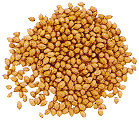 |
Cardamom - This rhizomatous herb with strongly aromatic seeds inside capsular
fruits is the most exotic of the spices. Largely grown in the western Ghats of Kerala and
Tamilnadu, it is widely used in Asian and middle east food preparation, medicines and even
in beverages. A concoction made of cardamom and coffee (called as Gahwa in the middle
east) is popular amongst some in India. Cardamom is aromatic, stimulating, slightly
astringent and refreshing. In ancient lore, powdered cardamom is used as an aphrodisiac.
Health Benefits of Cardamom : Traditional Indian Medicine used Cardamom for digestive remedy as it eases stomach pain due to colic and gas. The volatile oil in Cardamom - Cineol is effective in controlling chest congestion, cold, bronchitis and laryngitis. Cineol also control the growth of H.pylori responsible for ulcers. It also aids good blood circulation and prevent free radical damage which eventually leads to atherosclerosis. In addition it has a potent effect on controlling nausea and indigestion. It also has been used along with Ashwagandha (Withania somnifera) and Ginseng (Panax Ginseng) to boost sagging libido.
Latin - Elettaria cardamomum Maton
Family - Zingiberaceae
French - Cardamome
German - Kardamom
Tamil - Elakkai
Hindi - Elaichi
Kannada - Yelakki
Malayalam - Eelakkayi
|
 |
Cinnamon - This spice is derived from the tree Cinnamomum and is an important spice for most Indian dishes. It is available as rolls and shavings to impart mildly sweet and pungent taste to the dish. It acts as a preservative to meat recipes.
Health Benefits of Cinnamon : This wonder spice has a long list of health benefits - Controls cold, chest congestion, Acne, nausea, diarrhea, Cholesterol, triglycerides, uterine hemorrhage and
menorrhagia. Its strong antibacterial and antifungal properties kill salmonella and other types of bad bacteria. Cinnamon is advised for controlling diabetes, ulcer, gastero-intestional problems including worm infestation in Traditional Indian Medicine. Powdered Cinnamon taken with milk in the night can provide all the listed benefits.
Latin - Cinnamomum verum
Family - Cinnamomum
French - Cannelle
German - Zimt
Tamil - Karuvai Pattai
Kannada - Dalchini Sakke
Hindi - Dalchini
Malayalam - Karuvai
|
 |
Cloves are used in Indian dishes for a long time to add strong flavor to curries and meat items. No traditional Indian non-vegetarian dish would be complete without a few cloves. Originally from Indonesia, Cloves have become standard fare in Asian and middle eastern cuisine for centuries. Generally cloves are used as whole when you temper the oil before you add ingredients. When the food is served, these cloves are removed at the table. On the other hand, cloves are ground along with other spices like Cardamom and Cinnamon in masalas and marinades.
Health Benefits of Cloves: Indian herbal medicine and Ayurveda extol the virtues of Clove and its essential oil. Cloves contain eugenol oil which acts as analgesic in relieving tooth ache. Freshly ground cloves can be used as a poultice to relieve headache. Be warned that clove oil and clove should be sparingly applied on the skin or gum. Cloves aid digestion and relieve symptoms like nausea, bloating and excessive gas. Cloves kill some parasites in the intestines. Mildly anaesthetic, Cloves can reduce nerve sensitivity in Irritable Bowl Syndrome. Clove has antifungal properties too which can be useful against athlete's foot.
Latin: Syzygium aromaticum
Family:Myrtaceae
French: clou de girofle
German: Gewurznelke
Tamil:Krambu
Hindi: Lavang
Kannada: Lavange
|
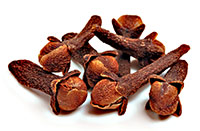 |
Mustard is another common spice found in the Indian spice rack. In traditional Indian cuisine, before you fry any item, the oil has to be tempered with mustard seeds which crackle in hot oil. Mustard seeds are used for tempering, seasoning and for its unique taste in most Indian dishes. South Indian Coconut chutneys are finally seasoned with a ladle of crackling mustard seeds and curry leaves in oil.
Health Benefits of Mustard Seed: Mustard seeds enhance circulation and ward off cold and congestion when applied as poultice on the chest or eaten. Mustard seeds act as rubefacient ( they draw blood to the skin surface which turns red) and help to alleviate muscular pains and head ache. Black mustard seeds are strongly pungent and should not be applied on sensitive skin.
Latin: Brassica juncea
Family: Brassicaceae
French: moutarde
German: Senfkorner
Tamil: Kadugu
Hindi: Sarson
Kannada: Sasuve
Malayalam: katuku
|
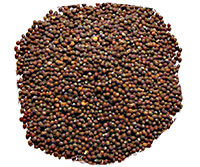 |
Turmeric is native to India and has been used in Indian Cuisine and traditional Indian medicines for thousands of years. Turmeric powder is a key ingredient in Curries and the root has the primary role of embellishing the harvest festival in India. In Pongal, turmeric plant with the root is kept as a symbol of health and prosperity for the farmers. Freshly ground turmeric root is applied on the face to control the growth of facial hair for South Indian women. Turmeric powder is used as preservative in Indian kitchen. It imparts the familiar yellow color to the food.
Health Benefits of Turmeric: The key ingredient in Turmeric is Curcumin which has many health benefits - from healing allergic and inflammatory conditions due to its strong antioxidant properties. It controls high blood cholesterol levels, nausea, gastritis, liver disorders and Crohn's disease. It is also used to prevent cancer. Turmeric also has another potent antooxidant - tartaric acid which gives the spice its unique sour taste
Latin: Curcuma longa
Family: Zingiberaceae
French: Curcuma
German: kurkuma
Tamil: Manjal
Hindi: Haldi
Malayalam: manjal
Kannada: Arashina
|
 |
Fenugreek is an essential Indian spice that flavors Idli batter to the famed Tamil Vendaya Kuzhambu Curry, pickles and chutneys. Fenugreek Seeds make the idlis soft and fluffy. Fenugreek seed based curries help digestion.
Health Benefits of Fenugreek Seeds: These are mucilaginous and heal inflammation, ulcers and lowers bad cholesterol LDL levels, triglycerides and blood sugar levels in the blood. Fenugreek seeds are used in some Indian Medicine to improve vigor and fertility in men. Fenugreek seeds have to be soaked overnight to render their hard exterior pliable so that they can be easily digested. Ground fenugreek seed poultice are helpful for wounds, rashes, boils and cuts. Fenugreek seeds are used in Indian medicines as uterine stimulant to reduce the painful conditions of Dysmenorrhea. Fenugreek also improves milk production.
Latin: Trigonella foenum graecum
Family: Fabaceae
French: fenugrec
German: Bockshornkleesamen
Tamil: Vendayam
Hindi: Methi
Kannada: Menthe
Malayalam: Uluva
|
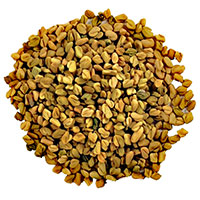 |
Nutmeg adds hot spicy flavor to the food. It is the key ingredient to the classic Béchamel sauce. In Indian kitchens, grated nutmeg is used to flavor Nutty Kheers, Soups, Cakes and masala powders. As it aids digestion, several Mughal cuisine use nutmeg in their spice blend.
Health Benefits of Nutmeg: Nutmeg is useful to improve digestion, enhance poor appetite, reduce flatulence and improves the quality of sleep. It also helps to control kidney issues. In ancient Tamil medicine, Nutmeg is used to delay premature ejaculation. It is claimed to have mild Aphrodisiac properties. But as nutmeg also has hallucinogenic properties, it can cause hallucination and in some cases death if taken in large doses.
Latin: Myristica fragrans
Family: Myristicaceae
Tamil: Jadika
Hindi: Jaiphal
Kannada: jakayi
|
 |
Star Anise is a spice used to flavor curries and soups. Star Anise is one of the ingredients used to make the Chinese 5 Spice powder. Star anise, Fennel, Cinnamon, Black Pepper and Cloves are roasted and finely ground. This five-spice powder is similar to the North Indian Garam Masala powder which can add spice to any food. Star Anise has Anethole a volatile oil that imparts the sweet licorice like flavor. Anethole is 13 times sweeter than sugar. But a surfeit of it can make the dish bitter. Usually it is like Cinnamon - in the sense, when the dish is served, the whole Star Anise is discarded.
Health Benefits of Star Anise: Traditional Chinese Medicine (TCM) have used this spice as an expectorant to clear the respiratory tract, as an aid to improve appetite and relieve abdominal gas and bloating. Star Anise has Shikimic acid which is used in making the drug Oseltamivir (Tamiflu). Researchers have identified some elements in the spice - Star Anise, which significantly fight against some virus like Epstein Barr. Star Anise is effective in treating bacteria that cause cavities.
Anise decoction helps to improve vitality and vigor in men.
Latin:Illicium verum
Family: Illiciaceae
Tamil: Nachathira sombu
Hindi: Chakra phool
Kannada: Annasi hovu
|
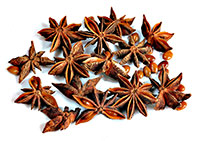 |
Tamarind is a key ingredient in most South Indian gravy dish - Sambar, Rasam, Puli Kuzhambu, to name a few. Its sour acidic nature acts as a food preservative. Generally, if a dish contains Tamarind and it is without coconut, it can keep for at least 2 days in the hot climate of Southern India. Puli thanni a Tamil word for Tamarind extract is used as a dip sauce for Samosas. North Indians use Tamarind extract with curd to float their Pan Puris. Tamarind is a key ingredient in the bottled condiment - Worcestershire Sauce.
Health Benefits of Tamarind: The key component of Tamarind is tartaric acid, a potent anti oxidant, which gives the spice its unique sour taste. South Indians use tons of Tamarind in their cuisine almost on a daily basis. They rarely suffer from Kidney Stone or Stomach Cancer. Some research suggests a link between the addition of spices like tamarind and turmeric and the lower incidence of colon cancer and Kidney stones in South India. Traditional Indian medicine postulates Tamarind for treating Diabetes type 1.
Recent research suggests that tamarind extract provides better relief to the dry eye than the normal treatment option of Hyaluronic acid.
Latin: Tamarindus indica
Family: Caesalpiniaceae
Tamil: Puli
Hindi: Imli
Kannada: Hunise hannu
Malayalam: Puli
|
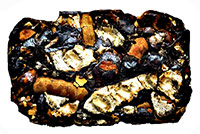 |
Bay Leaf is one of the main ingredients to spice up Mughal dishes like Biryani, Pulav and Brinji ( a variant of Pulav). This is the reason why in Tamil it is called as 'Birinji Elai'. It has a strong flavor and aroma when added in hot oil. It releases strong volatile oils when heated. Bay leaves have long been cherished in Indian cuisine for flavoring meat and vegetables. Vegetable Khurma will not be complete without a few sprigs of Bay leaf. Even the humble 'Uppuma' is flavored with Bay leaves for that exotic touch.
Health Benefits of Bay Leaf: Bay leaves have many volatile oils which act as powerful anti oxidants. Chiefly they have a volatile oil called as Cineole which along with a class of compounds known as sesquiterpenes act against the Diabetes disease. They not only act against raised blood sugar levels, but also lower triglyceride levels and LDL. Bay leaves will leave you spellbound when you learn that another compound found in Bay leaves - Parthenolide inhibit cancer and tumors. Traditional Indian Medicine use Bay leaf to improve digestion and to treat ulcers and retard the growth of bad bacteria in the stomach.
Latin: Laurus nobilis
Family: Lauraceae
Tamil: Brinji Ilai
Hindi: Tej patta
Kannada: Patraka
Malayalam: Karuka patta
|
 |
Poppy seed adds nutty flavor to the food and mainly used to add some 'body' to the curries. Poppy seeds are reputed to have beneficial effects in stomach ailments such as internal hemorrhages, diarrhea and dysentery. In traditional Indian Medicine poppy seeds are considered as a nervine tonic toning up reproductive organs and also as an Aphrodisiac.
Latin: Papaver somniferum
Family: Papaveraceae
Tamil: Kasakasa
Hindi: khuskhus
Kannada: gase gase
Malayalam: kas kas
|
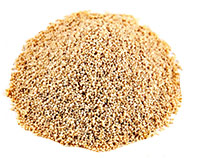 |
Sesame Seeds / Dill Sesame seeds or as they are popularly called as 'Dil' in India are important to spice many dishes. Sesame seeds are used in making balls called as 'Ell urundai'. In Chinese cuisine, chunks of meat or sea food dipped in batter is rolled on roasted white sesame seeds to make delicious deep fried snacks. The nutty flavored crunchy sesame seeds are used to coat many a dish.
Health Benefits of Sesame Seed: Sesame seeds contain lignans like sesamin and Sesamolin which reduce blood pressure and increase blood levels of Potassium. It also lowers blood cholesterol levels and potentiates the action of Vitamin E. In Tamil Nadu, the cold pressed sesame oil is called as 'Nalla Ennai' meaning 'good oil' probably alluding to its healthy properties. Some researchers are positive about the role of Sesame seeds in controlling cancerous growth and in slowing down the progress of Beta-amyloid plaques which afflict Alzheimer patients.
Latin: Anethum graveolens
Family: Apiaceae
Tamil: Ell
Kannada: Ellu
Hindi: Til
Malayalam: Ellu
|
 |
Asafoetida - This spice is a preparation made out of dried latex
(oleo-gum-resin) exuded from the living rhizome, rootstock or taproot of an umbelliferous
plant Ferula foetida (Umbelliferae). Also known as Devil's dung, Indian
asafoetida comes in three forms: 'tears', 'mass' and 'paste', according to quality. It is
available as light brown resin or more traditionally as powder. Its aroma is unmistakable
in most South Indian dishes. This spice is one of the most important ingredients in rasam which controls stomach gas - the bloated sensation, belching and flatulence.
Latin - Ferula asafoetida
Family - Apiaceae
French - Ferule Asafoetida
German - Stinkendes steckenkraut
Tamil - Perungaiyam
Hindi - Hing
Kannada - Hingu
Malayalam - Perungayam
|
 |
Saffron - This is the most expensive spice as it requires about 100,000 blooms,
laboriously handpicked to process one kilo of saffron. It is the slender, dried,
reddish-brown, flattened stigma of a small crocus of the iris family. In Indian medicine,
saffron (nicknamed as the Golden spice) is used to 'invoke' fairer children, if
fed early in pregnancy. Its characteristic aroma and a 'biting' taste is often used in
Biryani. Moghuls cooks boiled Saffron in milk and used this to color their Biryani.
Latin - Crocus sativus
Family - Iridaceae
French - Safran
German - Safran
Tamil - Kunkuma poo
Hindi - Kesar
|
 |
Making Garam Masala at home: Garam Masala literally 'hot spicy mixture' in Hindi is almost used in just about everything to flavour and spice up. It can be sprinkled in soups to salads. As you can guess from its name - Garam masala - originated in North India, probably under the Moghal patronage. Compared with the hot spicy South Indian Madras Curry Powder, garam masala is nowhere near the hot scale. You can buy ready made commercial garam masala from anywhere. But if you are reading this, you are unlikely to be satisfied with the commercial grade spice mixture. You would want fresh wholesome home made masala. Every home in India treasures its heritage - at least in food. The recipes in this page is no different. It is handed down from one generation to another.
What You Need : Get the spices fresh. Pay attention to the way the spices are packed. Pack the spices in hermetically tight metal containers, you could retain the aroma and flavor for months.
- Coriander Seeds - 5 Tablespoon
- Cumin Seeds - 3 Tablespoon
- Peppercorns - 2 Tablespoon
- Cardamom - 1 tablespoon
- Cinnamon Roll - about 4 inch long
- Cloves - 1 teaspoon
- Caraway seeds - 1 tablespoon
- Nutmeg 1
Method: In a heavy Kadai ( or Wok, Dutch oven or whatever you have in kitchen with a heavy bottom) dry roast each spice separately - except cinnamon and nutmeg. Stir often or you will end up burning the spices. You should be done with each spice for about a couple of minutes. Cool the spices.
Use a sharp knife to cut the cinnamon roll into smaller pieces. Start the grinding process with the nutmeg first. Then add the roasted spices and finally the cinnamon. Grind them to a fine powder.
Store the Garam masala in an air-tight container. This masala will keep for about 5 to 6 months.
Madras Curry Powder : This Curry Powder is one of the oldest traditional masala powders from India. It is hotter than the Garam masala and used to flavor - from Idlies to 'Chat'.
What you need At the risk of repeating what was said earlier - I will say again: Get the Spices Fresh. Store the spices in air-tight containers. Most spices have a shelf life of just about 6 months.
- Coriander Seeds - 5 Tablespoon
- Cumin Seeds - 3 Tablespoon
- Mustard Seeds (Kadugu) - 2 tablespoon
- Peppercorns - 2 Tablespoon
- Red Chili Powder - 1 tablespoon
- Dried Ginger Powder - 2 teaspoon
Method: Dry roast the spices except powders - separately in a heavy bottomed vessel (Kadai, Wok or Dutch oven). When you roast the spices, don't burn them. Dry roasting releases the volatile oils from the spices. Your kitchen will have a strong aroma of spices.
Then grind them together. Finally add the chili powder and the dried ginger powder and mix well. Store the Curry powder in an air-tight jar. This Madras Curry masala will keep for about 6 months if kept air-tight after every use.
 | The Free ebook Indian Spicy Recipes deals with recipes culled from this vast subcontinent using some of the exotic spices. The following is a brief note on a few of the spices grown in India. |
|
























































